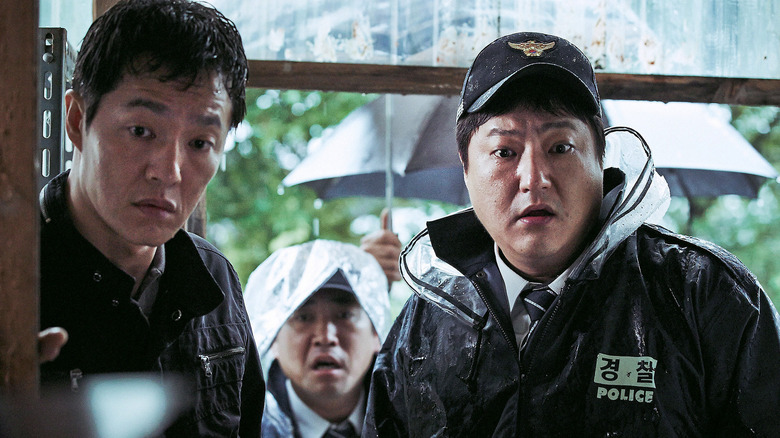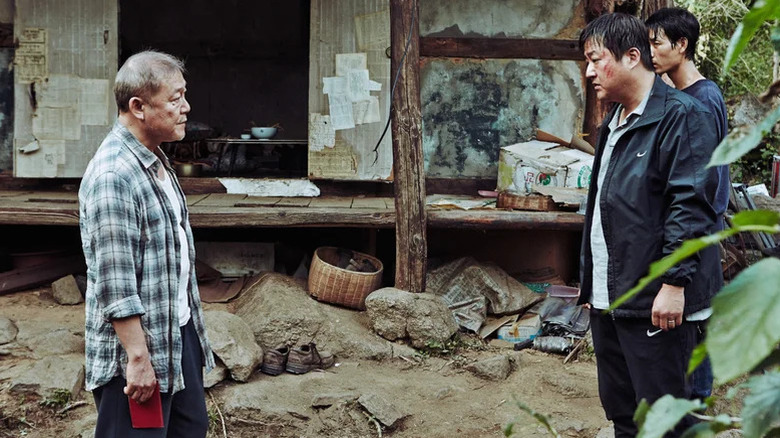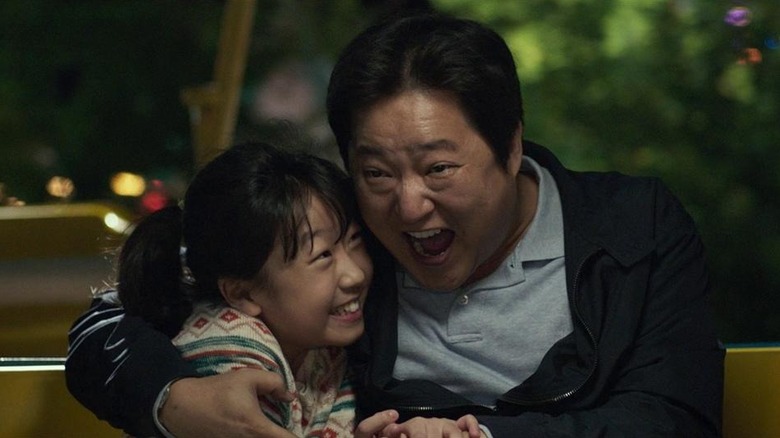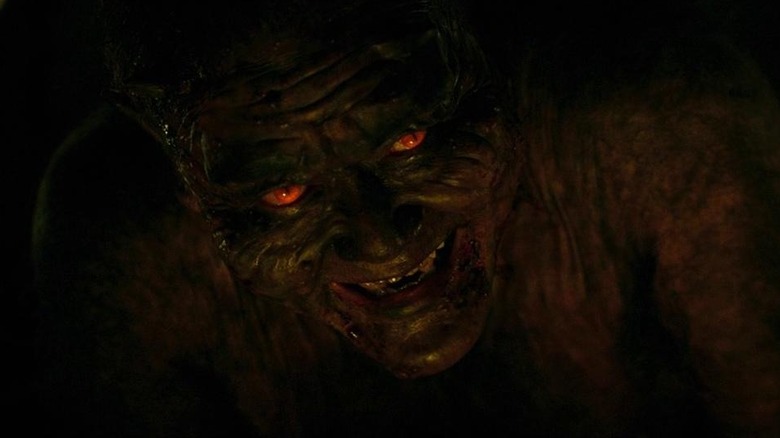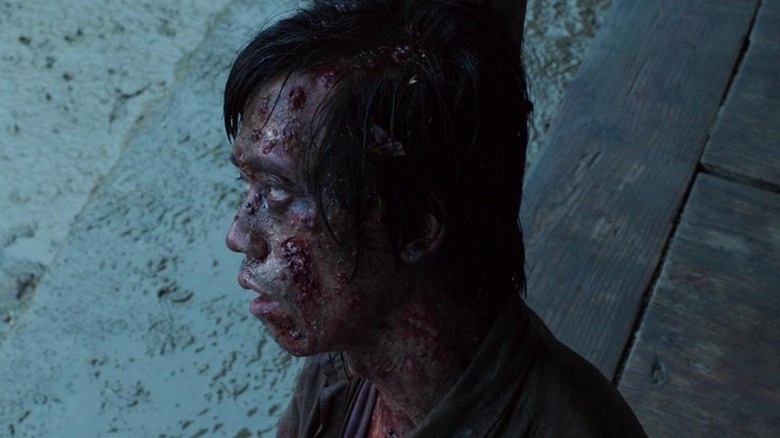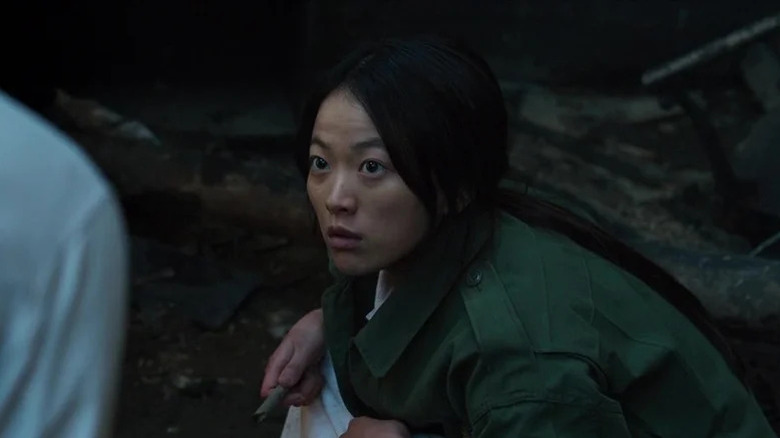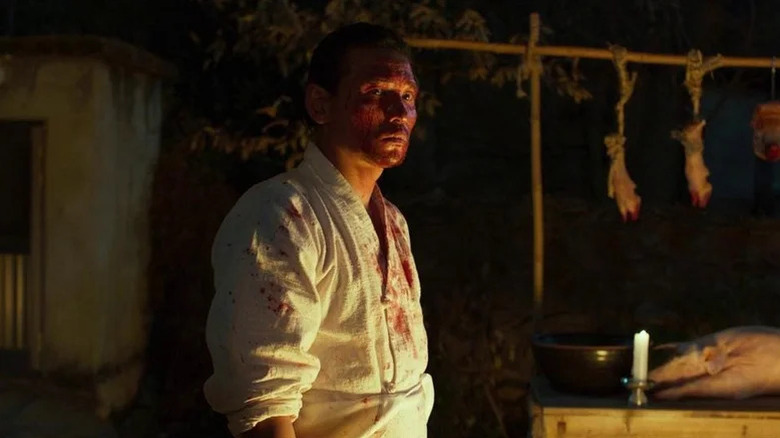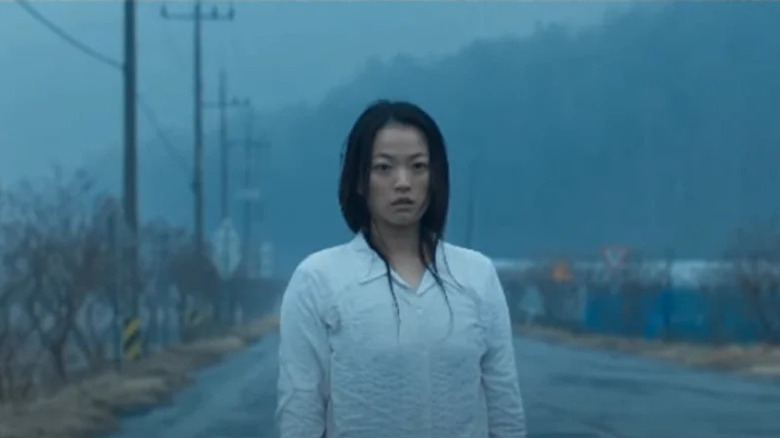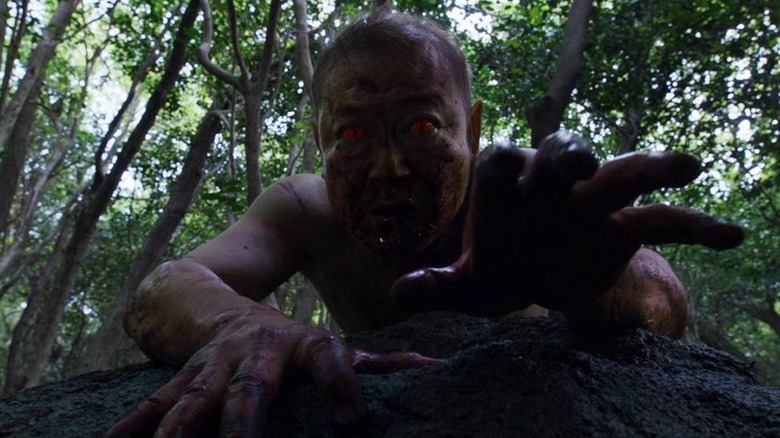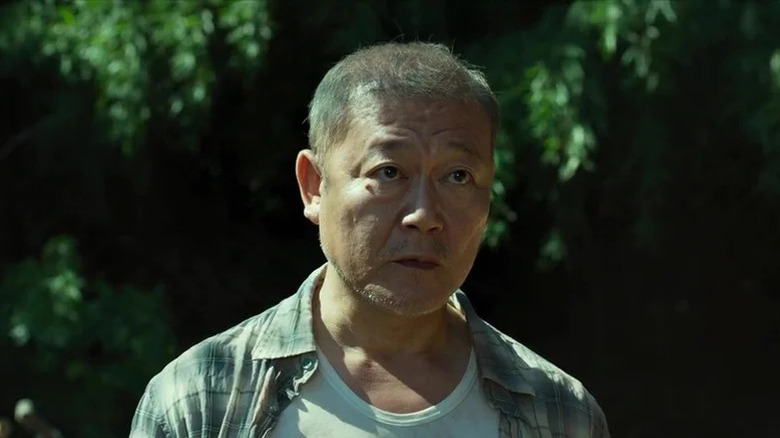The Wailing Ending Explained: A Father's Final Fatal Failure
We may receive a commission on purchases made from links.
One of the best Korean horror movies ever made, 2016's "The Wailing" is a roller coaster ride with enough twists and turns to keep even the most experienced movie watcher guessing. Set in the small mountain village of Gokseong, the movie follows bumbling police officer Jong-goo (Kwak Do-won) as he tries to solve the mystery of an infection that causes people to become mentally unwell and kill their loved ones. The infection and its effects are horrifying enough, but then Jong-goo's daughter, Hyo-jin (Kim Hwan-hee), becomes sick as well. Desperate to save her, Jong-goo will do just about anything, delving into solutions both spiritual and mundane. He recruits the help of his friends, co-workers, and a local shaman named Il-gwang (Hwang Jung-min), but it seems like the evil descending on Gokseong is too much for anyone to stop.
Upsetting in a way that's on par with horror movies like "Hereditary," the ending of "The Wailing" is a horrific tragedy that offers possible explanations for its events without ever confirming them directly. It's definitely something seriously spooky and supernatural, but the exact details are up for the audience's interpretation. Was the infection a demonic possession, the work of a vengeful ghost, or something else entirely? Whatever it is, it's terrifying.
What you need to remember about the plot of The Wailing
While investigating the first wild family murder, Jong-goo meets Moo-myung (Chun Woo-hee), a mysterious woman in white at the crime scene whose name literally means "no name." She tells him that the mother of the family was cursed by the Japanese man who lived in the woods (Jun Kunimura) and that a shaman could have maybe stopped it. When Hyo-jin starts behaving strangely and a tell-tale rash appears on her, Jong-goo, his wife, and his mother-in-law hire Il-gwang to try and help.
Along with the assistance of a young deacon who speaks Japanese, Jong-goo and his co-worker go to investigate the Japanese man, and they find a shrine with photos of victims of the infection and murders. They also find Hyo-jin's shoe, which sends Jong-goo into a fury. He returns to the man's house and finds that the shrine and photos have been burned, which prompts him to destroy the shrine room and kill the man's dog before telling him to get out of town.
Il-gwang comes to do a ritual that will rid Hyo-jin of the illness, but he tells Jong-goo that it's very dangerous and he cannot be interrupted. Unfortunately, Hyo-jin feels incredible pain during the ritual, as does the Japanese man. She begs Jong-goo to make Il-gwang stop and he does, which allows the evil to continue to take root within Hyo-jin.
What happened at the end of The Wailing
Following the botched ritual, Hyo-jin starts getting worse. Jong-goo takes a group of his friends and they go to beat up the Japanese man, who manages to get away before they hit him with their vehicle and chuck his body over the side of the mountain. When Jong-goo gets home, Hyo-jin seems like she's really starting to recover. Il-gwang has his doubts, however, and he returns to Jong-goo's home to try and tell him that he thinks they targeted the wrong person. While there, he sees Moo-myung, who causes him to begin vomiting blood. He escapes back to his vehicle, calling Jong-goo and telling him that Moo-myung is the real cause of the infection. Jong-goo ends up seeing Moo-myung and she tries to tell him to trust her, claiming she's set a trap for the Japanese man (who she says is the real demon). Unsure of who to trust, Jong-goo ends up leaving Moo-myung and ruins her trap, allowing evil to enter the house.
At the same time, the deacon finds the Japanese man in a cave, discovering that he has survived somehow. He turns into a demon, terrifying the deacon. Jong-goo walks into his house to find that Hyo-jin killed her mother and grandmother, at which point she stabs him. As he lay dying, he thinks about happier times with his daughter.
The end of The Wailing explained: faith, trust, and a demonic metaphor
"The Wailing" is asking massive questions about the nature of humanity and morality. Though it has a somewhat definitive ending in terms of its characters' fates, the actual meaning of it all is much more ambiguous. Like many of the best exorcism movies, the supernatural elements help explore much more human evils, as pure demonic evil is sometimes an easier idea for audiences to process than the same level of evil in humanity. The demonic presence can represent many things, from violent ideologies that can feel infectious or actual infections introduced to new populations, in turn representing colonialism. It's really up to each individual viewer to derive meaning from this extremely complex film.
The biggest questions the film asks are about faith and trust, and Jong-goo's biggest failure ends up being his distrust of Moo-myung, who tries to help him avert his fate. Instead, he ends up trusting Il-gwang, who is likely working with the demon. Jong-goo is indecisive and bumbling throughout, and he fails one last time, running back and breaking Moo-myung's protection spell. As he runs across his property, a flower she had tied up withers and dies, signifying the evil entering the house. If only he had a bit of faith and a bit of trust in Moo-myung, he might have survived.
What was the infection in The Wailing, and why does it target families?
The infection is caused by The Stranger, who turns out to be the real demon in "The Wailing." He moves from village to village, family to family, infecting one member of the family with the rash. Different reasons are given throughout the movie for why he attacks certain families, including the idea that he selected Hyo-jin because of the perceived sins of her father. However, it's just as likely that he chooses his victims through pure happenstance, given the evil he represents can often be truly unpredictable. The infection is more demonic possession than "Walking Dead"-style zombie outbreak, but it still targets innocent victims on the way.
It also seems like the demon is in cahoots with Il-gwang, as the shaman tries to convince Jong-goo that Moo-myung is actually the demonic force. It's possible that they only started working together after the botched exorcism of Hyo-jin. EIther that or they've been conspiring with one another for a while, using the demon's talents to help the shaman make some extra money. Even if Il-gwang is a lesser evil, it definitely seems like the Japanese man is the ultimate evil in "The Wailing," as confirmed by the fact that he not only survived his horrific hit-and-run but that he reveals himself to the deacon as one of the scariest devils in cinema history.
Who was the woman in white, and why didn't Jong-goo trust her?
So, who exactly is Moo-myung, the woman in white? It's most likely that she's a ghost or maybe even some kind of angelic force, and she's definitely benevolent despite Jong-goo's distrust of her. She's obviously connected to the murders, and when she tries to grab Jong-goo's wrist to prevent him from breaking her trap, he notices that she's wearing items that belonged to many of the victims. She also causes Il-gwang to vomit blood when he tries to warn Jong-goo, but this could be because she knows he is working with the demon and is actually trying to protect Jong-goo. She's a supernatural being of some kind with ties to shamanism; as she tells Jong-goo, a shaman could have prevented the murders, which helps prove her innocence. After all, if she was trying to murder others herself, why would she give Jong-goo the tools to bring about her own destruction?
While Moo-myung seems like a force for good, her recommendation for a shaman leads Jong-goo to Il-gwang, whose intentions are much more ambiguous. Was he working with the demon all along? Or did he end up falling in line with the demon after the failed exorcism?
Why didn't the shaman's exorcism work, and was he a villain?
The shamanic ritual to try and save Hyo-jin ends up not working because Jong-goo is unable to fully commit to the rules set forth, choosing his daughter's temporary comfort over stopping the evil. Il-gwang warns Jong-goo that the ritual is dangerous to perform and he cannot be interrupted, and it's yet another example of Jong-goo being unable to stick by his convictions in any way. While it's understandable that he wanted to stop the pain his daughter was experiencing, he didn't truly think of the long-term consequences. It's incredibly short-sighted, and Jong-goo ends up not having enough faith in anything to stop the evil descending upon his home.
It's possible that Il-gwang wasn't in league with the demon until after Jong-goo interrupted the ritual, allowing the demon to use that interruption to exert control over the shaman. It's also possible that he was working with the demon all along and might have even lured him to Gokseong in the first place. The former makes more sense with the film's themes around indecision and lapses of faith, though there could be a read on the film that all occult dealings are evil and therefore all of the supernatural beings are somehow dangerous, but that feels like a bit of a stretch.
What does the alternate ending of The Wailing mean?
There isn't an alternate ending for "The Wailing" so much as there is an extended one that follows the Japanese man after Hyo-jin kills her family. He waits on the side of the road across from a bus stop, being friendly to a little girl waiting there with her family. The little girl runs across the road to say hello, but her mother grabs her, protecting her in a way that Jong-goo was unable to protect his own daughter. Moo-myung walks out of the brush to watch and sees Il-gwang drive up in an SUV, stopping to pick up the Japanese stranger. It confirms that the Japanese man was, in fact, the demonic force and that he and Il-gwang were working together.
While it's an extremely bleak horror movie ending that shows evil not only winning but going on to do more evil, it's also a definitive ending that hands the answers to the audience. It's not quite as good, unfortunately, as the ambiguous ending that closes with Jong-goo's memories of happier days. Forcing the audience to contend with the same level of mystery as Jong-goo and his family makes for a more compelling experience, and the viewer will be haunted by the theatrical ending for long after the credits roll.
What has the director said about the ending of The Wailing?
In an interview with Korea JoonAng Daily, writer and director Na Hong-jin said that he saw someone online who broke down his exact original intentions for the ending, only to have others disagree vehemently, which made sense based on how he approached the film. "I expected that there would be many different views on the movie," he remarked. "It is obvious when 400 people watch a movie, there will be 400 different interpretations."
But what inspired Na Hong-jin to explore such challenging ideas in the first place? In a 2016 interview with The Playlist, he explained that he was inspired after a series of personal tragedies that made him question why good people sometimes suffered terrible fates:
"Attending a funeral had become rather a common ordeal for me, but it felt much worse back then. The deceased were my close friends, and in no way felt like a 'common' experience. Unfortunately, their deaths were not of natural causes, leaving those who are left behind all the more sorrowful. Funerals usually last three days in Korea, and all throughout those days I pondered about their deaths. The questions raised during those days coincided with the things I have always been wondering while making my previous films. The question was, 'Why did THEY have to be victims OF ALL PEOPLE?' I already had the answers for the 'How.' What I had to find out was the 'Why.'"
This led him to consult with religious leaders from across a number of faiths and belief systems, which pushed him to create a story where a man's lack of faith in anything is what leads to his ultimate demise.
The Stranger being Japanese has layered meanings
One final question that might plague audiences, especially those outside of Korea, is why the Stranger was a Japanese man. Was Na trying to make a commentary on xenophobia and distrust between Korean and Japanese people? In a 2016 interview with ScreenAnarchy, Na revealed that while he wanted the Stranger to be someone foreign to Korea, it was also because he wanted the villagers to struggle in communicating with the character. At the same time, he wanted the Stranger to still have some similarities to the villagers. In his own words:
"The father isn't someone who is defending himself with a shield from something like knives coming before him. He's more like someone who is hiding in a castle and must defend his castle. Strangers invade yet he doesn't know if they are allies or enemies. This was the kind of threat that I wanted to express. It's like a hidden threat deep inside. I felt that this would be more terrifying than a dynamic threat — something dwelling inside and not visible. I wanted to show this threat through someone with similar physical characteristics to Koreans. This is why I cast a Japanese actor. As time went by he would reveal his true nature and we would realize that he is different and that even communication is impossible. I wanted to express the fear coming from this impossibility of communication."
Like the horror movie's controversial ending, the Stranger's Japanese origins lends itself to multiple interpretations beyond Na's intent — doubly so when you take Japan's colonization and occupation of Korea from 1910-1945 into consideration (and how it led to resentments that last to this day among some South Koreans). Depending on your perspective, "The Wailing" has many, many different meanings, making it one of the most complex and engaging horror films of its decade.
